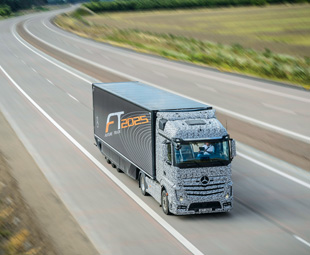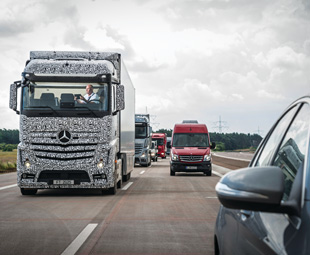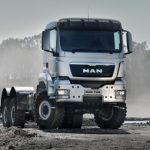Making history!

FOCUS was recently invited to the German town of Magdeburg to witness a world first: a Mercedes-Benz Actros that drives itself. I decided that this momentous occasion was deserving of a very special article. So brace yourself for what I believe is another world first – an interview with a truck!
You’re looking pretty smug. I gather you’re something quite special?
Absolutely! I’m the Mercedes-Benz Future Truck 2025! You know the autopilot systems that have been used in aeroplanes for years? Well this type of technology is now available in a truck – for the very first time. Incidentally, this technology is also being used very successfully in large freight ships …
So you’re the world’s first autonomous truck – are you something quite spectacular?
Yes and no. I have to concede that my technology is utterly spectacular. But, when I do my job, I do so quietly and effortlessly. There are no fireworks.
Are you saying that there aren’t really any tangible signs of your many talents?
Not many. When the driver gets into my cab, he will notice a message announcing “Highway Pilot available”. That means I am ready and willing to take over the driving. All the driver need do is switch on the system and remove his hands from the steering wheel. I then take over, continuing to travel at exactly the set speed, in the centre of the outside lane.
What should the driver do at this time?
He can relax or work. For instance, he can go onto his iPad and book his parking place, schnitzel and shower at the next truck stop while I am driving. He can complete his tax return, or he can schedule his next delivery. The driver doesn’t even need to face forward; he can shift his seat backwards and around to the right by 45o – all at the push of a button on the armrest of his seat. Then he can stretch his legs, just as he would at home while sitting on the couch.
Surely this means that the driver cannot reach the brakes?
You’re right, but that’s not a problem. I will brake if need be.
I would imagine that you’d make traffic jams far less stressful?
Absolutely. Those are a big problem here in Germany. In fact, the length of traffic tailbacks on motorways and major highways totalled just under 600 000 km in 2012, and drivers spent a total of 230 000 hours stationary in traffic. I can ease the driver’s frustrations at this time; he can surf the internet or read a book while stuck in traffic.
Could the driver take a nap?
No. I have a seat occupation detection system and I also boast eye detection, which warns a driver if he’s tired. It’s vitally important for the driver to stay awake.
Why?
 You never know what could happen. An emergency could arise, so the driver needs to be alert. He (or she for that matter) can always override my technology by steering, braking or accelerating as required. I’m not there to replace the driver. He or she remains responsible.
You never know what could happen. An emergency could arise, so the driver needs to be alert. He (or she for that matter) can always override my technology by steering, braking or accelerating as required. I’m not there to replace the driver. He or she remains responsible.
So, if an emergency vehicle approaches, the driver must take over?
Not necessarily. I can deal with that. A message will appear on my display, indicating that an emergency vehicle is approaching, and I will automatically move over to the right until I reach the lane marking, clearing the way for the fast-moving emergency vehicle. Once it has passed, I will return to the centre of
my lane.
What happens if a vehicle has broken down in the emergency lane? Can you deal with that?
Certainly. I will announce the vehicle, slow down, move left to the centreline and safely pass the broken-down
vehicle. Thereafter I will return to the right-hand lane and accelerate back to cruising speed.
I must say that you do sound rather clever. Have you mastered overtaking too?
Not yet. If I come up behind a vehicle and I’m in autonomous mode, I will follow it patiently. In this instance, the driver can resume control, indicate, pass the slower vehicle and then pop me back into “Highway Pilot” – or autonomous – mode.
How do you believe drivers will react to your introduction?
Obviously there will be some scepticism. Driver education will clearly be needed, but I think that autonomous trucks will do wonders for the truck driving profession. They will elevate the job of the truck driver immensely, which should entice young people into the profession. After all, the truck is the driver’s workstation. If that workstation becomes more sophisticated and attractive, that can only be a good thing.
Can you work in all weather conditions?
 No. In order to do my job, I use sensors, a stereo camera behind the windscreen, three-dimensional maps and networking. If those sensors are covered by snow or ice, I lose my “eyes” and so autonomous driving is impossible.
No. In order to do my job, I use sensors, a stereo camera behind the windscreen, three-dimensional maps and networking. If those sensors are covered by snow or ice, I lose my “eyes” and so autonomous driving is impossible.
What about severe winds?
Those aren’t a problem; even gusting crosswinds won’t make a difference. My course is corrected automatically and far more efficiently than any human driver could ever achieve.
You referred to networking. Why is that necessary?
It’s integral to the whole concept. I use V2V/V2I communication, which stands for Vehicle to Vehicle and Vehicle to Infrastructure (in other words, the exchange of information between yours truly and other vehicles, and with the world outside the motorway).
This means that I am constantly transmitting information to my surroundings and to other vehicles. Practically, this means that other vehicles can respond accordingly (brake if necessary) and traffic control centres can change speed limits or open up additional lanes if necessary. In essence we’re talking real-time communication between the networked vehicles that cannot be matched by even the most precise radio traffic reports.
I’m sold. When will autonomous trucks be common on European roads?
In 2025.
I would imagine that there are huge challenges that need to be resolved before autonomous trucks become commonplace?
Certainly, but the legal, technical and social issues surrounding autonomous driving are already being investigated by the German government. Traffic regulations will need to change too. It’s highly likely that many of these challenges will be overcome by the end of this decade.
Then, of course, there is the big issue of insurance. What happens if you cause an accident? Who is liable? Your manufacturer or your driver or the company that owns you?
Those are issues that will require a lot of investigation and consultation, although I do need to point out that one of my goals is to improve road safety. Some 90 percent of accidents are caused by driver error – and I don’t make human errors. Also remember that machines don’t get tired; they don’t have a bad day.
Finally, the big question. Any plans to come to South Africa?
Right now, that’s unlikely. Your roads aren’t ideal. Optimally, I need two lanes and really good road markings, and this clearly isn’t the norm in South Africa. That’s a real pity; I would be ideal for use on a route like Johannesburg to Cape Town …
Published by
Focus on Transport
focusmagsa




 !
From 1 Apri
!
From 1 Apri

 Big news from FOCUS on Transport + Logist
Big news from FOCUS on Transport + Logist





 FUSO: Driving the Future of Mobile Healthc
FUSO: Driving the Future of Mobile Healthc



 A brand
A brand




 Wondering about the maximum legal load for a
Wondering about the maximum legal load for a 
 The MAN hTGX powered by a hydrogen combus
The MAN hTGX powered by a hydrogen combus

 Exciting News for South African Operators
Exciting News for South African Operators
